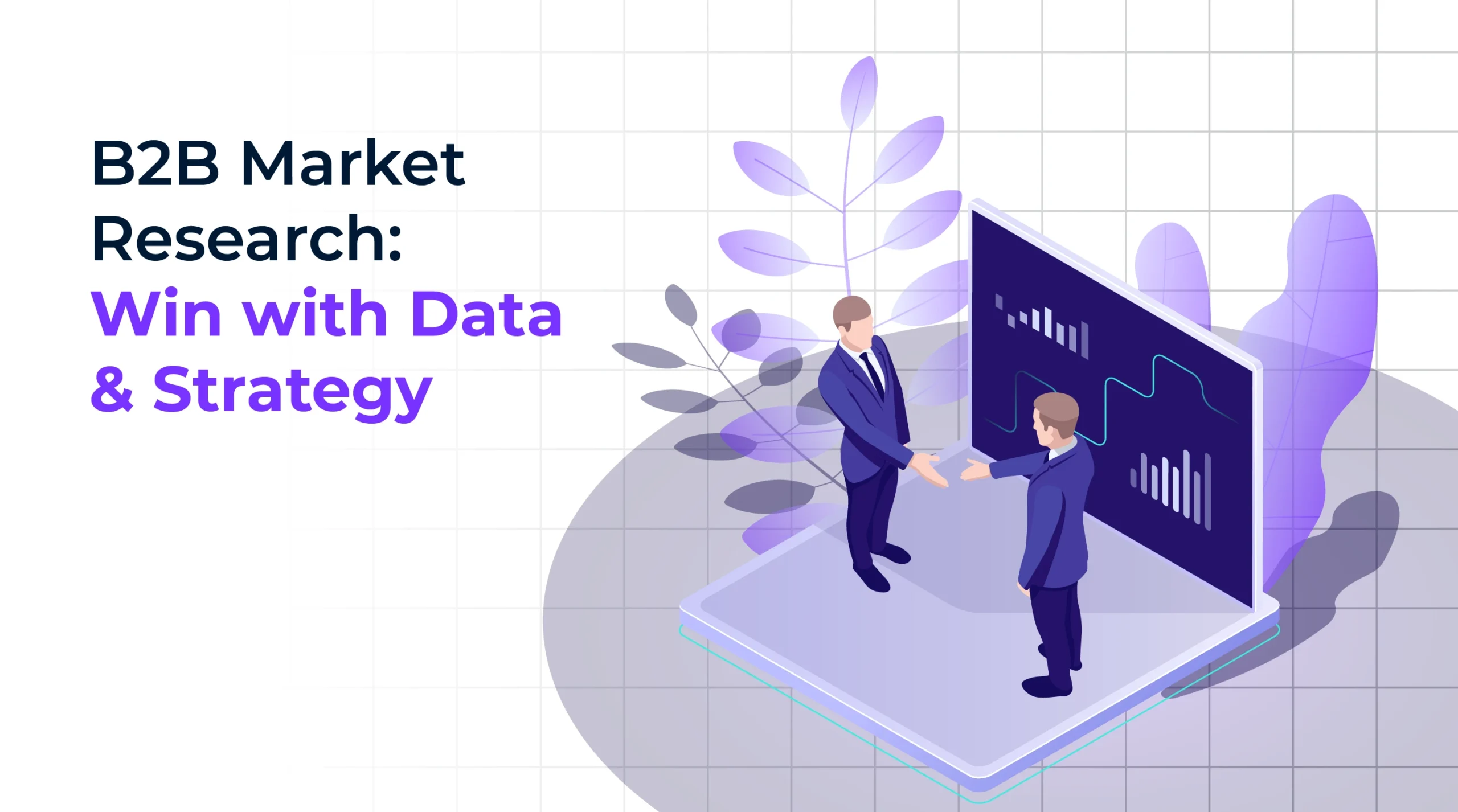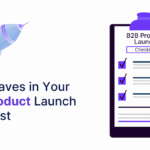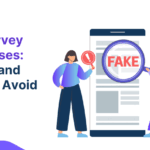
In 2011, Netflix nearly went under. It had misjudged the market, raising prices without understanding how its core B2B licensing deals would react. Customers left in droves. But Netflix learned. They used B2B market research strategies to predict consumer demand and made the shift towards streaming. A decade later, it dominates.
B2B success is not luck. It’s about research. Understanding competitors, analyzing the industry, and tracking B2B buyer behavior. In this article, let’s break down the market research methods that you need for growth. Competitive intelligence tactics that reveal opportunities. And the data-driven strategies that separate industry giants from the ones struggling to keep afloat.
Understanding B2B Market Research
Market research is the pillar on which most B2B buyer behavior stand. It was never an afterthought, but now it has become even more important. From the old giants to new startups, everyone is using some sort of market research strategy.
It is not a stretch to say that market research is the foundation of decision-making in the B2B world. Don’t believe me? 90% of B2B buyers begin their buy journey with an online search, and 67% of them start their journey online. This means that ineffective and archaic strategies just won’t cut it anymore. Your slow surveys, generic competitor reports, and google based research.

But before we begin it is essential we differentiate between business-to-business and business-to-customer. B2B is the dealing between two companies, or businesses. B2C is your average Joe buying something from some company.
Business-to-business research is not the same as B2C. In B2C, buying decisions are impulsive, personal, and emotional. In B2B, purchases are methodical, based on logic, ROI, and long-term value. Deals take longer to close. Many stakeholders, procurement teams, and decision-makers are involved. A potential to either make or break millions of dollars.
But how do businesses gather these insights? They use research methodologies built for high-value, complex decision-making.
| Factor | B2B Market Research | B2C Market Research |
|---|---|---|
| Decision-Making Process | Logical, ROI-driven, multi-stakeholder | Emotional, impulse-driven, individual consumer |
| Sales Cycle | Long and complex | Short and transactional |
| Customer Relationship | Long-term engagement and contracts | One-time purchases or short-term loyalty |
| Research Focus | Competitive analysis, industry trends, pain points | Consumer preferences, brand perception, lifestyle trends |
Key B2B Market Research Strategies
The days of surface-level market research are over. Asking a few customers what they think, scraping together a half-baked competitor analysis, and hoping for the best is a guaranteed way to lose market share. Companies that win in B2B conduct research that is deep, structured, and tailored to their industry.
Types of Market Research
There are two broad ways to approach market research: primary and secondary methods. Businesses that rely only on one are leaving massive gaps in their strategy.

Primary Market Research
Primary research is direct. It involves talking to real decision-makers, running interviews, and conducting controlled studies to understand what drives business purchases. Surveys, while useful, are not enough. If you are serious about your research project, you will begin by talking to experts. This means conducting in-depth interviews (IDI) and focus groups with experts to uncover unseen pain points. These discussions reveal why deals are won or lost; what objections hold the most weight; and what changes would actually convince customers to switch vendors.
Secondary Market Research
Secondary research fills in the rest of the picture. It involves analyzing industry reports, competitive intelligence, and digital analytics. This is where you use reports from market research firm, government publications, and other sources. It’s where a business may analyze their competitors’ pricing models, product positioning, and marketing strategies. And it’s where digital tools like SEO research, social listening, and data scraping come into play. If a competitor is gaining traction, secondary research tells you why.
For a company to predict future trends, it must integrate both primary and secondary market research. An integrated approach helps identify shifts in B2B buyer behavior before it happens. Basically, instead of a reaction to sudden change, you would expect it and prepare.
| Research Type | Description | Example Methods |
|---|---|---|
| Primary Research | Direct data collection from industry experts, buyers, and stakeholders | Interviews, focus groups, surveys |
| Secondary Research | Analyzing pre-existing reports and market data | Industry reports, competitive benchmarking, SEO analysis |
Competitive Analysis in B2B
Every business says they “keep an eye on the competition.” But most are doing it wrong. Checking a competitor’s website once in a while or glancing at their LinkedIn ads isn’t analysis. It’s passive observation. In competitive analysis in B2B, you methodically and deliberately breakdown how your competitors position themselves. Learn where they’re strong, and where they’re weak, and how to outmaneuver them.
| Metric | Why It Matters | Example |
|---|---|---|
| Conversion Rate | Measures effectiveness of sales funnel | A competitor with 5% vs. your 2% may indicate weak CTAs or poor targeting |
| Customer Churn Rate | Shows customer retention strength | High churn suggests competitors offer better service or pricing |
| SEO Performance | Determines online visibility | Competitor ranking for high-value keywords vs. your brand |
Identifying Competition
A proper competitive analysis starts with identifying the real competition. You may ask what does “real competition” means. You might think that keeping an eye out for businesses that offer similar products and services is your competition. But that is only the first part. It also includes companies that are competing for the same customers. The former is called direct competition, the latter indirect competition.
Your competition can also be external or internal. External is straightforward: all those who are competing against you. Internal can manifest as inefficiencies, and unintegrated verticals. The biggest mistake businesses make? Underestimating indirect and internal competitors. In fact, B2B SaaS churn reached an all-time high in 2023 (-1.85% MRR churn), reflecting how competitive pressures and internal inefficiencies can severely impact growth.
For example, a B2B SaaS firm might think its biggest rival is another software company. In reality, it could be internal IT departments convincing executives to build in-house solutions instead of buying.
These internal challenges align with B2B e-commerce trends, where enterprises prioritize blockchain and AI integration to streamline procurement, reducing reliance on external tools.
Watching your competitors isn’t enough. Real insight comes from understanding how they position themselves. Where they’re vulnerable. And what decision-makers really think about them. Nexus delivers that clarity by pairing competitive market research with expert consultations and tailored surveys. The results? You will know what others are doing and exactly how to outperform them.
SWOT Analysis
Once the competition is clear, the next step is a SWOT analysis. For a reliable SWOT, you must use actual data. Theoretical numbers are fine, but they won’t help you in the real world.

What Makes a Reliable SWOT?
A credible SWOT analysis relies on real, quantifiable data, not theoretical data. B2B e-commerce, for example, is projected to grow at an 18.04% CAGR from 2024 to 2034, driven by AI/ML adoption and supply chain digitization. These external trends are critical components to include in a well-rounded SWOT analysis.
While speculative numbers may provide a good starting point, they fail to anchor strategy in reality. Instead, focus on actual performance indicators. This becomes even more vital as only 6% of B2B organizations are classified as advanced insight-driven businesses, a gap that data-driven SWOTs can help address.
- Strengths and Weaknesses (Internal Focus): Your internal evaluation must dive deep into measurable metrics like:
- KPIs (Key Performance Indicators): How is your team or product meeting its goals?
- Employee Evaluations: Are your key personnel driving or hindering progress?
- Integration Capabilities: How does your business operate across departments?
- Opportunities and Threats (External Focus): The external evaluation is critical. This means aligning your analysis with actual market trends:
- Market Changes: Are new technologies or customer behavior creating gaps you can fill?
- Competitor Movements: Did they secure a funding round or expand?
- Buyer Sentiment: What does the data tell you about customer needs and expectations?
SWOT analysis is a practical tool. It evaluates internal strengths and weaknesses while identifying external opportunities and threats. It might seem like a fancy-colored chart at the end of the day, but a lot of work goes into making that chart.
| SWOT Element | Focus Area | Example Data Points |
|---|---|---|
| Strengths | Internal advantages | Strong brand recognition, proprietary technology |
| Weaknesses | Internal disadvantages | High customer churn rate, poor digital presence |
| Opportunities | External market trends | Emerging AI-driven analytics, new B2B buying behaviors |
| Threats | External risks | New competitors entering the market, regulatory changes |
Benchmarking
Then comes benchmarking. This is where numbers come in. Competitive benchmarking involves tracking your competitor’s conversion rates, sales cycles, customer churn, and pricing elasticity.
For example, B2B SaaS YoY growth declined by 21.9% in 2023, with December MRR growth dropping to -4%. These benchmarks reveal how companies are adjusting to competitive and market changes.
Analyzing their product features side-by-side and understanding what customers are looking for. Notably, mobile-optimized websites have been shown to generate 8% more sales than non-optimized ones, providing a clear advantage in digital benchmarking.
Seems like a lot of work, doesn’t it? Without it, you won’t have a solid understanding of where you stand in relation to your competitors.
Digital Intelligence
And finally, there’s digital intelligence. This is where tools like Ahrefs, SEMrush, and LinkedIn analytics come in. To put it in simpler terms:
Digital intelligence tools are invaluable here. Statistics show that 64% of sales teams using social selling meet quotas compared to only 49% without, highlighting how LinkedIn analytics can uncover strategic advantages.
Think of digital intelligence as your B2B telescope. You can zoom in on the strategies that are helping competitors shine. Tools like Ahrefs and SEMrush act like astronomers’ charts. They can pinpoint where competitors are gaining traction online. That can be through SEO performance, keyword ranking, or backlinks.

LinkedIn analytics, on the other hand, is like a star map. It shows you how competitors’ network. What content their audience engages with, and where their influence is growing.
Digital intelligence is how businesses track their online presence and performance. If a competitor’s thought leadership articles are outperforming yours, why? If they’re getting more inbound leads through organic search, what keywords are responsible for that traffic?
Competitive analysis is not a one-time activity. It’s a continuous process. Markets Changed. Competitors adapted. New startups entered. You ought to think where do I stand, where do they stand, what I should do.
Defining B2B Customer Insights
Okay, you did your competitive analysis, but you still have to sell things. Who is your Ideal Customer? You might say that you are aware of who that is because you have been working for some time now. But what if you could sell more things to more people, more businesses?
B2B customer insights go a step beyond demographics and job titles. This is especially important as Millennials are involved in 73% of all B2B buying decisions, with 44% making the final decisions. Understanding generational preferences and their evaluation process allows businesses to adapt their sales strategies and maximize outreach. Such customer insight underscores how businesses evaluate vendors, prioritize spending, and make complex purchasing decisions.
Without structured research, businesses waste time targeting the wrong audience with the wrong message.
Understand B2B Buyer Behavior
B2B decision-making is rarely about a single person. Multiple stakeholders are involved, but you already knew that; it was in the name “B2B”. Expect your CFOs to analyze costs, procurement teams to negotiate contracts, and IT managers to assess technical fit. And everything in between. This is why B2B buyer behavior is fundamentally different from B2C.
With multiple stakeholders in play, the complexity requires a custom approach. This complexity is supported by findings showing that personalized email messages improve click-through rates by 14% and conversions by 10%, proving how targeted messaging directly impacts stakeholder engagement.

Decisions take longer. Risk aversion is higher. Relationships matter more. Companies that collect and apply B2B customer insights refine their sales strategies.
For instance, a CTO doesn’t prioritize pricing; they care about security and scalability. Understanding these motivations is what closes deals. Additionally, 64% of sales teams using social selling achieve their quotas, compared to 49% without it. This shows how targeted and personalized engagement moves you towards success in B2B selling.
Use Data to Predict Customer Behavior
The reason for conducting predictive analysis is not just to predict but also track. Customer behavior analytics plays a key role in this. as only 6% of B2B organizations are classified as advanced insight-driven businesses.
Companies adopting predictive tools to forecast trends and customer behavior gain a competitive edge in anticipating needs and closing deals. They analyze customer churn, buying cycles, and sales objections to predict which prospects are ready to convert and which are at risk of leaving.
Market Segmentation for B2B
Not all customers are the same. Each “segment” of the market requires that you change things to fit them as they are. The right market segment gets you the right customers. Market segmentation becomes crucial. For instance, 80% of B2B buyers expect a customer experience akin to B2C transactions.
Meeting these expectations requires businesses to identify and rank segments. They identify which segments generate the highest revenue. Segments that have the shortest sales cycles and are the easiest to retain.
Segmentation strategies like firmographics, technographics, and behavioral segmentation help identify high-value customer groups. Groups with shorter sales cycles and greater retention:

A cloud services provider wouldn’t market the same way to a Fortune 500 company as they would to a tech startup. The startup values flexibility and rapid deployment. The enterprise values compliance and security. Without market segmentation for B2B, marketing campaigns fail to resonate. Sales teams chase the wrong leads, and growth slows.
Data-driven Decisions in B2B Research
Gone is the time where your CEOs gut feeling could make you millions. In 2025, intuition isn’t enough. Your gut is likely to lose to someone with data-based decision making on their side. B2B company must be data-backed.
Which is why it is shocking that only 6% of B2B organizations are classified as advanced insight-driven businesses. That is a significant gap. But also, a great opportunity.
To make the best of this opportunity, your company must use predictive analytics to forecast future trends. Track customer behavior patterns, conversion rates, and market shifts to anticipate what’s coming next.
Predictive analytics plays a vital role here. 70% of B2B firms are now integrating AI strategies into their sales processes to forecast trends and customer needs.
Let’s say a competitor is undercutting prices and winning market share. Data analytics can tell you whether it’s a short-term plan or a long-term strategy. If a new trend is emerging in an industry, data tells businesses whether to invest or hold back.
Implementing B2B Market Research Findings
Research is useless if it isn’t applied. Many businesses collect data, generate reports, and then do nothing with the insights. This stagnation can be costly. Doubly because 75% of B2B buyers use social media content during their decision-making process. This makes real-time application of insights essential for success.
Key takeaway: research and then act on your research.
B2B market research methods guide product development, marketing campaigns, and sales processes.
If research shows that customers are frustrated with onboarding complexity. Businesses need to simplify the process. If B2B buyer behavior indicates that long-term contracts are a barrier. Companies need to introduce more flexible pricing. If business-to-business research reveals that competitors are outperforming in digital marketing, it’s time to revamp content strategy.
Even when acting on research, the key is real-time execution. For example, 37% of organizations plan to increase their marketing budgets. This means that there is an industry-wide need for continuous investment in data-driven strategies.
So maybe the key takeaway should be this: Research and act in real-time on your research.
Tracking B2B Industry Trends
In 2025, staying competitive means monitoring market changes continuously. Analyzing customer behavior in real time and adapting before competitors do.
AI and automation are revolutionizing B2B market research strategies. Real-time analytics provide instant insights into changing customer needs. Predictive models help businesses anticipate industry disruptions before they happen. Traditional research methods are slow, manual, and retrospective. And they are being replaced by real-time data-driven decision-making.
This shift is accelerated by AI-driven solutions. With 70% of B2B organizations using AI strategies to enhance sales processes and anticipate customer behavior more effectively.
Now you must move first, dominate new markets, and set the pace for everyone else. Refusing to evolve? You will disappear.
Conclusion
To sail the high waters of the business world is a real talent. To do that, businesses must recognize that surface-level approaches are obsolete. The integration of robust B2B market research methods and meticulous business-to-business research forms the bedrock of strategic planning. By meticulously executing competitive analysis in B2B and cultivating a profound understanding of customer insights, businesses can refine their target audience analysis to pinpoint precision.
Furthermore, the strategic implementation of market segmentation, coupled with vigilant tracking of B2B industry trends, enables organizations to leverage data-driven decision-making that anticipates and responds to the nuances of evolving B2B buyer behavior. Those who commit to these principles, and enact them with agility, will not just survive, but lead.









